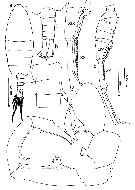|
|
 |
|
Calanoida ( Order ) |
|
|
|
Diaptomoidea ( Superfamily ) |
|
|
|
Tortanidae ( Family ) |
|
|
|
Tortanus ( Genus ) |
|
|
|
Atortus ( Sub-Genus ) |
|
|
| |
Tortanus (Atortus) indonesiensis Mulyadi, Nishida & Ohtsuka, 2017 (M) | |
| | | | | | | Ref.: | | | Mulyadi, Nishida & Ohtsuka, 2017 (p. 89, Descr. M, figs. M, Rem.) |  Issued from: Mulyadi, S. Nishida & S. Ohtsuka in Crustaceana, 2017, 90 (1). [p.60, Fig.7]. Male from 1°40'48''N, 125°04'12''E): a, habitus (dorsal); b, urosome (dorsal); c, urosomites 1-3 (dorsal); d, e, right A1 (number of ancestral segment indicated by Roman numerals); f, P5. Nota: - Prosome 2.8 times as long as urosome. - Posterior corners of prosome rounded and asymmetrical, with leftposterior margin produced more posteriorly than right. - Genital somite with genital aperture on left posterolateral margin. - Urosomite 2 with posterolateral and posteroventral processes on right side, the latter of which smaller, each with minute seta on tip. - Appendages as in male T. (A.) sulawesiensis except A1 and P5. - P5: Right leg with coxa semi-trapezoid with small distolateral process; basis triangular and expanded laterally, with digitiform process bearing 2 setae on proximomedial margin; exopod slightly curved medially, tapering distally into acute tip, and with 2 medial setae. Left leg coxa unarmed; basis elongate and straight, with cylindrical process bearing seta near proximal 1/3 of medial margin; exopodal segment 1 with proximomedial, cylindrical process bearing seta; exopodal segment 2 with proximomedial seta, mid-lateral seta, and subdistal lateral seta, tip of segment rounded with granular surface
| | | | | NZ: | 1 | | |
|
Distribution map of Tortanus (Atortus) indonesiensis by geographical zones
|
| | | | Loc: | | | Indonesia (off Tanjung Merah, Sulawesi Is.).
Type locality: 1°40'48'' N, 125°04'12'' E. | | | | N: | 1 | | | | Lg.: | | | (1314) M: 1,82-1,87; {M: 1,82-1,87} | | | | Rem.: | For Mulyadi & al. (2017, p.91), Tortanus (A.) indonesiensis belongs to the brevipes species complex, but cannot be assigned to either the longipes or the rubidus species group within that species complex, because the proximal end of the denticulate ridge of segment XX of the right A1 is raised from the surface plane of segment XIX (as
in the longipes species group), but the medial margin of the basis of the left P5 is not sinuate (as in the rubidus species group). However, T. (A.) indonesiensis is distinguished from the other species of the species complex by the characteristic semi-trapezoid process on the coxa of the male right P5. | | | Last update : 19/06/2023 | |
|
|
 Any use of this site for a publication will be mentioned with the following reference : Any use of this site for a publication will be mentioned with the following reference :
Razouls C., Desreumaux N., Kouwenberg J. and de Bovée F., 2005-2025. - Biodiversity of Marine Planktonic Copepods (morphology, geographical distribution and biological data). Sorbonne University, CNRS. Available at http://copepodes.obs-banyuls.fr/en [Accessed December 17, 2025] © copyright 2005-2025 Sorbonne University, CNRS
|
|
 |
 |




